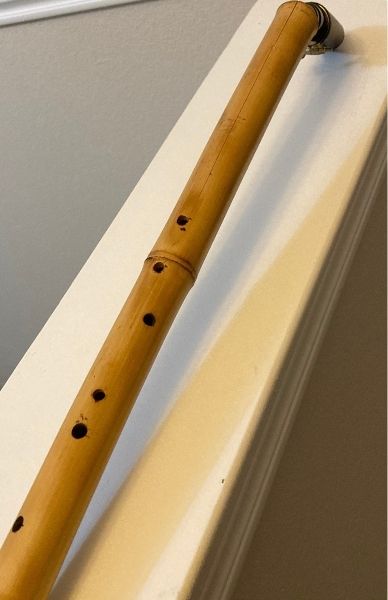Saxophones…they’re made of brass but use a reed and have keys similar to a clarinet, seems like it could have an identity crisis. I’ve been playing the saxophone for 30 years and have been asked countless times by family, friends, and even random people, is the saxophone a woodwind?
The saxophone is a member of the woodwind family of instruments. Even though the saxophone is made of brass, it creates its sound by air passing over a single reed and utilizes keys to modify tone. These are the major reasons why the sax is classified as a wind instrument.

All member of the saxophone family are classified as woodwinds even though all of them are made out brass and have varying shapes. Below I will also mention saxophones that are made of other materials but no matter what they’re made of, saxes are still considered woodwinds.
What Makes A Saxophone A Woodwind?
In general, a saxophone are considered woodwinds since they use a single reed to produce their sound. The other major factor is the face that saxophone use key mechanisms to change the tone of the instrument.
Saxophones are classified as single reed instruments, just like the clarinet. Other woodwinds, such as the oboe and bassoon, are called double reeds. All are considered woodwinds.
Reed
Saxophones use a single reed on a mouthpiece that the player blows air over to create sound. Air enter the mouthpiece and vibrates the reed. The vibrations cause the saxophone to create sound. If you look at a saxophone, you’ll notice that the reed is attached to the mouthpiece by a metal, hard rubber, or leather band called a ligature.
The type of reed and mouthpiece are important factors in how a saxophone sounds. Different materials for saxophone reeds (usually a hollow cane, but plastic reeds are gaining in popularity) and mouthpieces produce different tones.
Keys
All saxophones have keys that open and close holes along the length of the saxophone, which in turn changes the pitch that is produced when air is blown through it.
Saxophone key mechanisms are largely the same from saxophone to saxophone, however there are some slight differences that I cover in this article.
Sound Projection
Saxophones, and other woodwind instruments, use similar styles of key mechanisms to change the tones that they play. These instruments all have open holes (until the key is pressed) which allows sound to escape from all over the instrument, not just the bell like brass instruments.
The bell on saxophones is still a needed feature, since most of the sound does still come out of the bell, which helps to amplify and direct it a little better.

Why Are Saxophones Called “Horns?”
In general, saxophones are called “horns” more or less as a slang term similar to how guitar players call their instruments “axes.” “Horn,” in this sense, is a broad term that describes a woodwind or brass instrument to differentiate it from keyboards, percussive, or guitar instruments.
Horn is just one of those words that can be used to describe multiple things in the musical world. It’s one of those terms that you pickup the meaning of once you’re exposed to that word.
- Term for Any Woodwind or Brass Instrument – Horn can be used to describe pretty much any woodwind or brass instrument…though it seems most commonly used when referring to saxophones or brass instruments.
- More Literal – It can also be used in the literal sense when referring to French horns, which are more often called horns in F in music settings.
Why Are Saxophones Made Out Of Metal?
Saxophones are made of metal because the inventor, Adolph Sax, wanted to create an instrument that could produce both a soft sound to blend in with the orchestra and a powerful sound to stand out over other instruments.
Originally, Adolphe Sax intended for there to be two families of saxophone, one for military band (keys of Bb and Eb) and one for orchestra (keys of C and Bb.)
The metal body of the saxophone could play soft and melodic enough to blend in with the more nuanced orchestra sound but could also play loudly and stand out over instruments in military bands, which were traditionally brass heavy.
This is why saxophones are made out of brass, which is an alloy of metal that is made mostly of copper and zinc. The saxophone’s unique sound comes from the fact that it is a brass instrument with a single reed. This combination makes the saxophone louder than other brass instruments and gives it a unique timbre that helps it blend in with an orchestra.
Are There Saxophones That Aren’t Made Of Metal?
Generally, saxophones are made out of brass, but some plastic and wooden models have been built in the past. For example, Grafton produced a plastic saxophone back in the 1950’s that was famously played by Charlie Parker on his “Jazz at Massey Hall” album.
Other, so called, saxophones that are made out of plastic include the Yamaha YVS-100 Venova. It’s an open hole instruments (meaning you use your finger pads to close the holes rather than key mechanisms) but still uses a saxophone mouthpiece and reed.

There is also the Xaphoon Pocket Saxophone. One model is made from plastic while others in the product line are made of bamboo.
There are also saxophones that are made out of wood, though these are less common. The disadvantage of wood saxophones is that they are more difficult to keep in tune and they are not as durable as brass saxophones.
These instruments are called saxophones since they use saxophone mouthpieces and reeds and because they have fingerings that very closely match those of a standard saxophone.
These instruments are by no means substitutes for the real thing BUT, they do have unique sound qualities…often compared to a clarinet mixed with soprano sax…that make them worth checking out.
